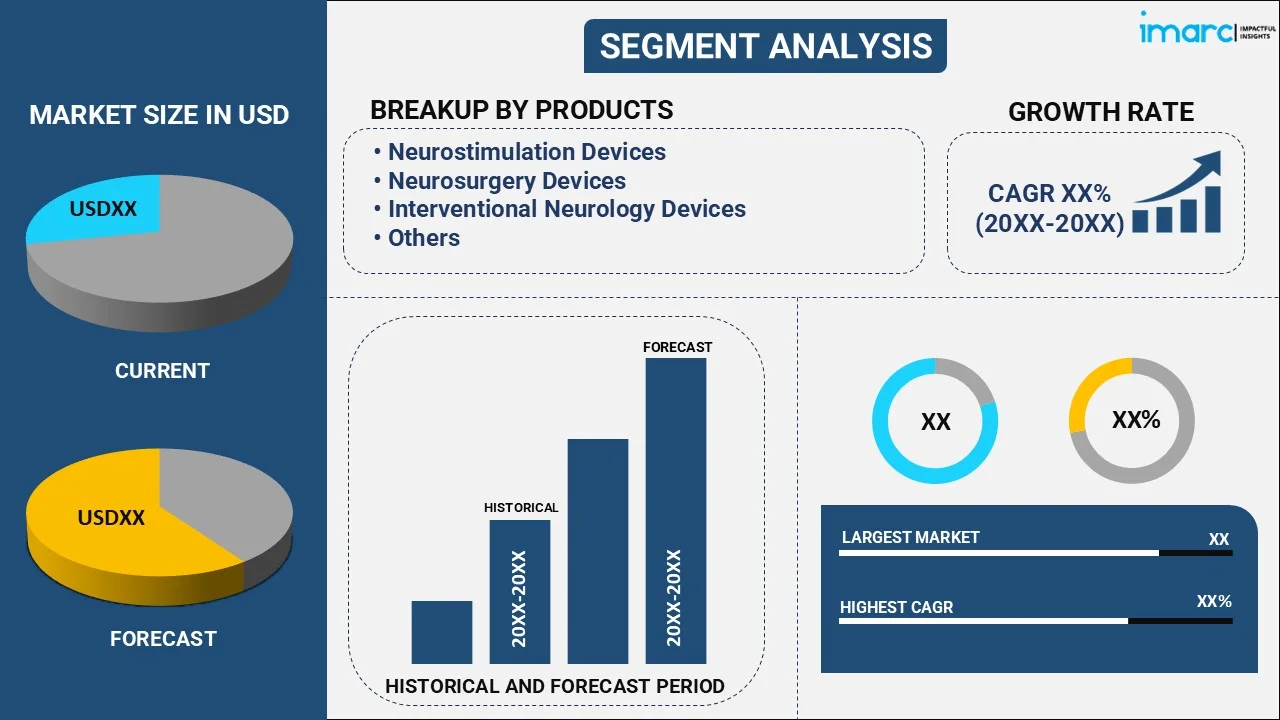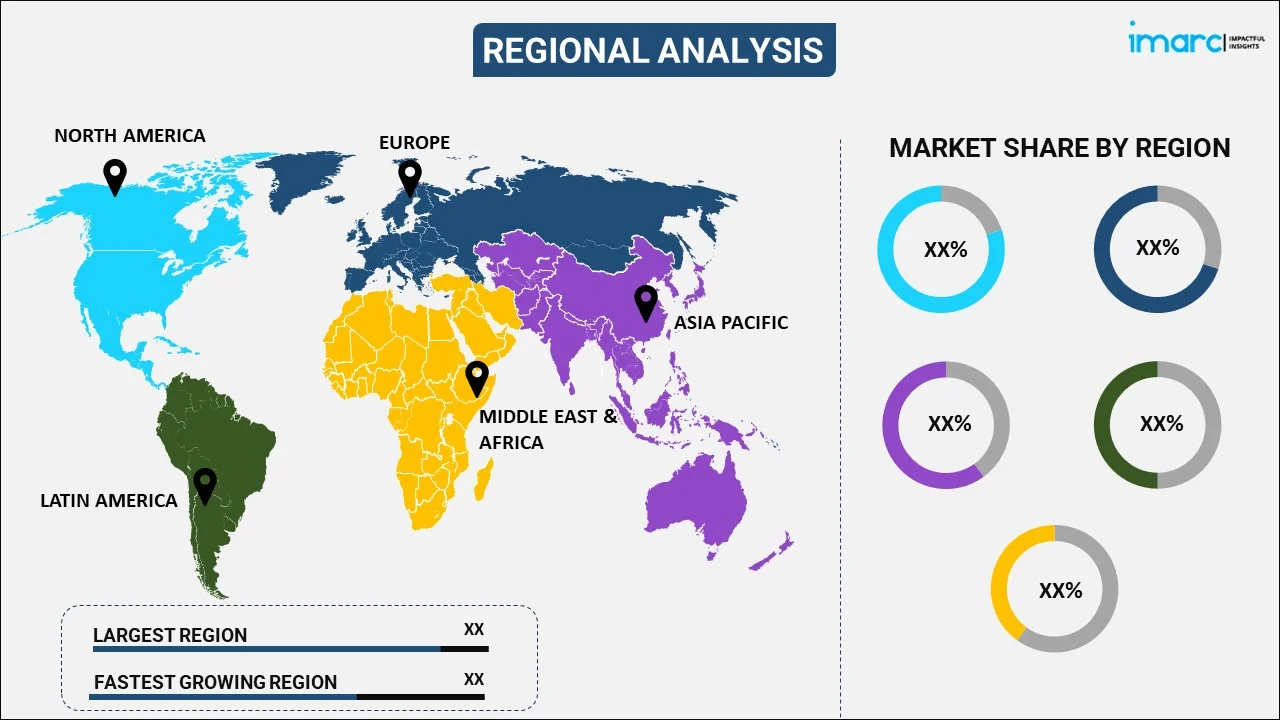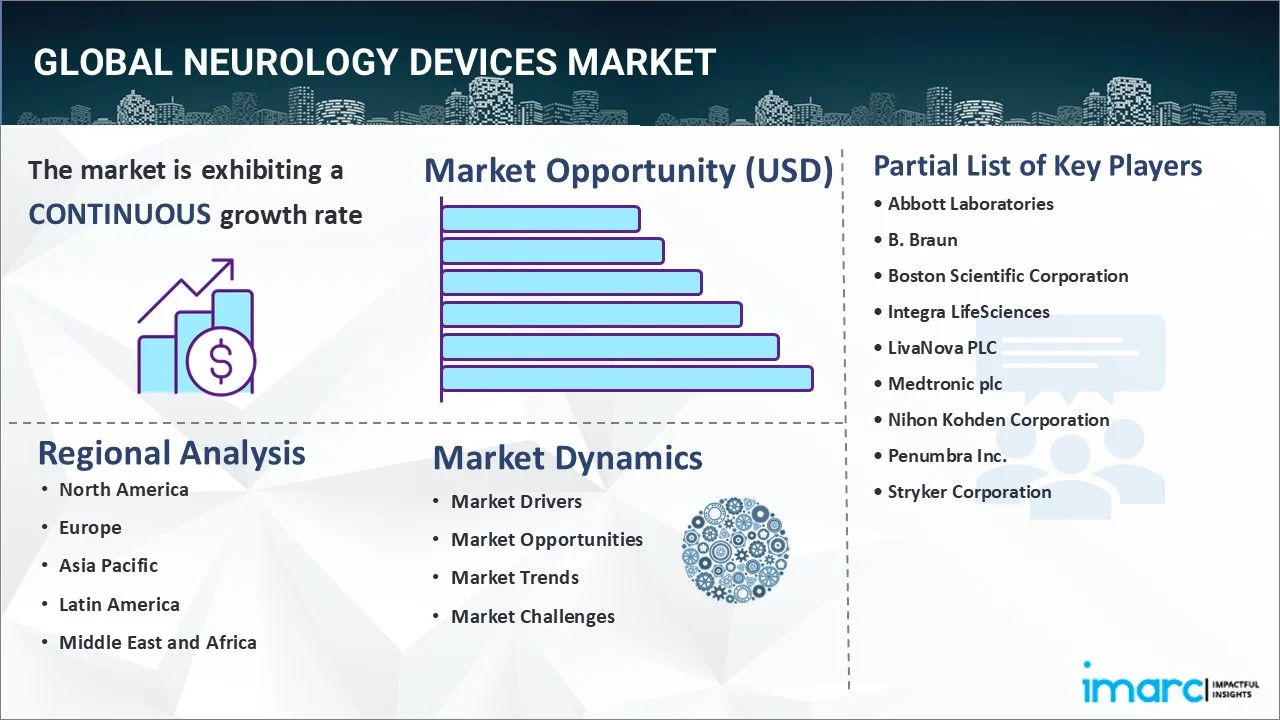
Neurology Devices Market Report by Product (Neurostimulation Devices, Neurosurgery Devices, Interventional Neurology Devices, Cerebrospinal Fluid Management Devices, and Others), End User (Hospitals, Ambulatory Surgery Centers, Neurology Clinics), and Region 2025-2033
Neurology Devices Market Overview:
The global neurology devices market size reached USD 14.4 Billion in 2024. Looking forward, IMARC Group expects the market to reach USD 26.6 Billion by 2033, exhibiting a growth rate (CAGR) of 6.72% during 2025-2033. There are various factors that are driving the market, which include increasing prevalence of various neurological disorders like epilepsy, Alzheimer’s disease, dementias, and cerebrovascular diseases, introduction of improved devices due to technological advancements, and rising geriatric population.
|
Report Attribute
|
Key Statistics
|
|---|---|
|
Base Year
|
2024 |
|
Forecast Years
|
2025-2033 |
|
Historical Years
|
2019-2024
|
| Market Size in 2024 | USD 14.4 Billion |
| Market Forecast in 2033 | USD 26.6 Billion |
| Market Growth Rate 2025-2033 | 6.72% |
Neurology Devices Market Analysis:
- Major Market Drivers: One of the key market drivers is favorable government initiatives. Moreover, the expansion of healthcare facilities is acting as a growth-inducing factor.
- Key Market Trends: The market demand is propelled, owing to numerous primary trends, which include rising incidences of various neurological disorders and the increasing geriatric population.
- Geographical Trends: According to the report, North America exhibits a clear dominance, accounting for the largest market share on account of the presence of advanced healthcare facilities.
- Competitive Landscape: Some of the major market players in the neurology devices industry are Abbott Laboratories, B. Braun, Boston Scientific Corporation, Integra LifeSciences, LivaNova PLC, Medtronic plc, Nihon Kohden Corporation, Penumbra Inc., and Stryker Corporation., among many others.
- Challenges and Opportunities: One of the key challenges hindering the market growth are regulatory hurdles. On the other hand, advancements in regenerative medicine and restorative therapies represent recent opportunities.
Neurology Devices Market Trends:
Increasing Prevalence of Neurological Disorders
According to the World Health Organization (WHO), the number of people with diabetic neuropathy was 206 Million in 2021. People are suffering from numerous neurological disorders on account of genetic disorders, infections, congenital abnormalities, lifestyle health problems including malnutrition, and brain, spinal cord, and nerve injury. These diseases have a negative impact on the life of individuals like poor coordination, muscle weakness, and loss of sensation. In addition, the rising need for effective and reliable solutions among patients is catalyzing the neurology device demand. These devices enable precise diagnosis of neurological conditions by allowing detailed visualization and monitoring of brain activity and structure.
Introduction of Improved Devices Due to Technological Advancements
Key players are focusing on introducing devices that have innovative technologies and can provide enhanced care to patients. They are offering devices that have telemedicine capabilities and allow for remote monitoring of patients. For example, Abbott released a new edition of its NeuroSphereTM myPathTM digital health app on 25 April 2022. This version has more features that will allow physicians to monitor their patients more carefully. While using a dorsal root ganglion (DRG) or spinal cord stimulation (SCS) therapy device, the patient, a doctor, and their team can view patient-reported outcome measurements together on a digital health app at every point of the treatment process.
Rising Geriatric Population
The increasing number of geriatric populations across the globe is offering a positive neurology devices market outlook. Owing to their increased vulnerability to neurological conditions such as dementia, stroke, Parkinson's disease, and Alzheimer's disease, older persons are becoming more and more in need of neurology equipment. Elderly people require more medical attention, and as neurological issues are more prevalent in this age group, there is a greater need for neurology services and supplies. The World Health Organization (WHO) projects that the number of persons aged 80 years or older is expected to reach 426 Million in 2050.
Neurology Devices Market Segmentation:
IMARC Group provides an analysis of the key trends in each segment of the market, along with neurology devices forecast at the global, regional, and country levels for 2025-2033. Our report has categorized the market based on product and end user.
Breakup by Product:

- Neurostimulation Devices
- Neurosurgery Devices
- Interventional Neurology Devices
- Cerebrospinal Fluid Management Devices
- Others
Neurostimulation devices account for the majority of the market share
The report has provided a detailed breakup and analysis of the market based on the product. This includes neurostimulation devices, neurosurgery devices, interventional neurology devices, cerebrospinal fluid management devices, and others. According to the report, neurostimulation devices represented the largest segment.
Neurostimulation devices play a crucial role in stimulating nerves and regulating faulty neural pathway behavior arising from the disease process by means of medication, electrical signals, or energy. They provide a customized approach to managing the patient's condition and can be adjusted to meet the needs of the individual. Neurostimulation offers an alternative that may reduce the need for medication or dosage for those who depend on it to control their symptoms. Additionally, these tools can help with focus, cognitive enhancement, better sleep, less stress, and treatment of conditions including depression, migraines, anxiety, and insomnia, which is contributing to the neurology devices market growth. Moreover, big players in the market are introducing new products and receiving money from authorities to enhance patient care. For instance, on 08 January 2024, the US FDA approved Medtronic plc's PerceptTM RC deep brain stimulation (DBS) system. The rechargeable neurostimulator is the newest member of the Medtronic PerceptTM family, which also includes the PerceptTM PC neurostimulator, BrainSenseTM technology, and SenSightTM directional leads. Individualized treatment plans can be created for patients with movement disorders such as essential tremor, dystonia, Parkinson's disease, and epilepsy using the only sensing-enabled DBS device in the PerceptTM family.
Breakup by End User:
- Hospitals
- Ambulatory Surgery Centers
- Neurology Clinics
Hospitals hold the largest share of the industry
A detailed breakup and analysis of the market based on the end user have also been provided in the report. This includes hospitals, ambulatory surgery centers, and neurology clinics. According to the report, hospitals accounted for the largest market share.
In 2021, there were approximately 165,000 hospitals worldwide, according to DiscoveryABATherapy. Hospitals are outfitted to offer full medical care, including sophisticated neurological disorder treatments, emergency services, and advanced diagnostics. As a result, they serve as the main locations for the use of various neurology devices. Furthermore, hospitals can accommodate a greater number of patients including those with neurological disorders as compared to other types of healthcare institutions. The need for neurology equipment in these settings is driven by the increased patient influx. These facilities also feature the infrastructure required to handle advanced neurological devices, as well as specialist medical personnel like neurologists, neurosurgeons, and specialized nursing care. This includes wards designed specifically for post-operative care and monitoring and operating rooms furnished for neurosurgery procedures.
Breakup by Region:

- North America
- United States
- Canada
- Asia-Pacific
- China
- Japan
- India
- South Korea
- Australia
- Indonesia
- Others
- Europe
- Germany
- France
- United Kingdom
- Italy
- Spain
- Russia
- Others
- Latin America
- Brazil
- Mexico
- Others
- Middle East and Africa
North America leads the market, accounting for the largest neurology devices market share
The report has also provided a comprehensive analysis of all the major regional markets, which include North America (the United States and Canada); Asia Pacific (China, Japan, India, South Korea, Australia, Indonesia, and others); Latin America (Brazil, Mexico, and others); Europe (Germany, France, the United Kingdom, Italy, Spain, Russia, and others); and the Middle East and Africa. According to the report, North America represents the largest regional market for neurology devices.
North America has modern medical technologies with state-of-the-art healthcare institutions. The region's medical research institutes are concentrating on research and development (R&D) endeavors, as these operations foster innovation and lead to the release of new neurological equipment onto the market. Apart from this, the market expansion is being aided by favorable government efforts in North America. Moreover, the high prevalence of neurological disorders among the North American population necessitates robust healthcare solutions. The need for neurology equipment in the region is fueled by their vital role in the management and treatment of various illnesses. As per the Alzheimer’s Association, there were will be around13 Million Americans that will suffer from Alzheimer's disease by 2050.
Competitive Landscape:
- The market research report has also provided a comprehensive analysis of the competitive landscape in the market. Detailed profiles of all major companies have also been provided. Some of the major market players in the neurology devices industry include Abbott Laboratories, B. Braun, Boston Scientific Corporation, Integra LifeSciences, LivaNova PLC, Medtronic plc, Nihon Kohden Corporation, Penumbra Inc., and Stryker Corporation.
(Please note that this is only a partial list of the key players, and the complete list is provided in the report.)
- Top companies in neurology devices industry are forming strategic mergers and acquisitions (M&As), partnerships, and collaborations to expand their product portfolios and geographical reach. They are creating novel and inventive products with improved efficacy and safety by investing in R&D activities. Additionally, companies are expanding their operations globally to tap into emerging markets where there is a growing awareness of neurological diseases and an increasing capability to spend on advanced medical treatments. This includes establishing production facilities or sales offices in new areas, which will also benefit in increasing their neurology devices market revenue. To remain competitive in the market, they are also launching new items and updating old ones. For instance, Abbott introduced its NeuroSphereTM Virtual Clinic in the United States on 8 March 2021. This innovative technology enables patients to interact with doctors, guarantee optimal settings and functionality, and obtain new treatment settings from a distance. Approved by the U.S. Food and Drug Administration (FDA), the NeuroSphere Virtual Clinic can increase access to optimal treatment for patients suffering from chronic pain or movement disorders.
Neurology Devices Market Recent Developments:
- 14 January 2021: Medtronic plc, announced the first enrollment in Adaptive DBS Algorithm for Personalized Therapy in Parkinson's Disease (ADAPT-PD), its trial evaluating the safety and efficacy of adaptive deep brain stimulation (aDBS) in patients with Parkinson's Disease (PD). Adaptive deep brain stimulation is an investigational feature of the Percept™ PC device.
- 12 January 2021: ClearMind Biomedical’s received the US Food and Drug Administration (FDA) 510k clearance for its new neuroendoscope, the Axonpen System. The system can illuminate and visualize intracranial tissue and fluids, and control tissue or fluid aspiration while performing a surgery.
Neurology Devices Market Report Scope:
| Report Features | Details |
|---|---|
| Base Year of the Analysis | 2024 |
| Historical Period | 2019-2024 |
| Forecast Period | 2025-2033 |
| Units | Billion USD |
| Scope of the Report | Exploration of Historical Trends and Market Outlook, Industry Catalysts and Challenges, Segment-Wise Historical and Future Market Assessment:
|
| Products Covered | Neurostimulation Devices, Neurosurgery Devices, Interventional Neurology Devices, Cerebrospinal Fluid Management Devices, Others |
| End Users Covered | Hospitals, Ambulatory Surgery Centers, Neurology Clinics |
| Regions Covered | Asia Pacific, Europe, North America, Latin America, Middle East and Africa |
| Countries Covered | United States, Canada, Germany, France, United Kingdom, Italy, Spain, Russia, China, Japan, India, South Korea, Australia, Indonesia, Brazil, Mexico |
| Companies Covered | Abbott Laboratories, B. Braun, Boston Scientific Corporation, Integra LifeSciences, LivaNova PLC, Medtronic plc, Nihon Kohden Corporation, Penumbra Inc., Stryker Corporation, etc. |
| Customization Scope | 10% Free Customization |
| Post-Sale Analyst Support | 10-12 Weeks |
| Delivery Format | PDF and Excel through Email (We can also provide the editable version of the report in PPT/Word format on special request) |
Key Benefits for Stakeholders:
- IMARC’s industry report offers a comprehensive quantitative analysis of various market segments, historical and current market trends, market forecasts, and dynamics of the market from 2019-2033.
- The research report provides the latest information on the market drivers, challenges, and neurology devices market recent opportunities in the market.
- The study maps the leading, as well as the fastest-growing, regional markets. It further enables stakeholders to identify the key country-level markets within each region.
- Porter's five forces analysis assists stakeholders in assessing the impact of new entrants, competitive rivalry, supplier power, buyer power, and the threat of substitution. It helps stakeholders to analyze the level of competition within the neurology devices industry and its attractiveness.
- The competitive landscape allows stakeholders to understand their competitive environment and provides insight into the current positions of key players in the market.
Key Questions Answered in This Report
The global neurology devices market was valued at USD 14.4 Billion in 2024.
We expect the global neurology devices market to exhibit a CAGR of 6.72% during 2025-2033.
The rising adoption of neurology devices to treat complex disorders, such as obsessive-compulsive disorder, Parkinson's disease, dystonia, chronic pain, etc., is primarily driving the global neurology devices market.
The sudden outbreak of the COVID-19 pandemic had led to the postponement of numerous elective treatments for neurological ailments to reduce the risk of the coronavirus infection upon hospital visits and interaction with medical devices, thereby negatively impacting the global market for neurology devices.
Based on the product, the global neurology devices market has been segregated into neurostimulation devices, neurosurgery devices, interventional neurology devices, cerebrospinal fluid management devices, and others. Among these, neurostimulation devices currently hold the largest market share.
Based on the end user, the global neurology devices market can be bifurcated into hospitals, ambulatory surgery centers, and neurology clinics. Currently, hospitals exhibit a clear dominance in the market.
On a regional level, the market has been classified into North America, Asia-Pacific, Europe, Latin America, and Middle East and Africa, where North America currently dominates the global market.
Some of the major players in the global neurology devices market include Abbott Laboratories, B. Braun, Boston Scientific Corporation, Integra LifeSciences, LivaNova PLC, Medtronic plc, Nihon Kohden Corporation, Penumbra Inc., and Stryker Corporation.
Need more help?
- Speak to our experienced analysts for insights on the current market scenarios.
- Include additional segments and countries to customize the report as per your requirement.
- Gain an unparalleled competitive advantage in your domain by understanding how to utilize the report and positively impacting your operations and revenue.
- For further assistance, please connect with our analysts.

 Inquire Before Buying
Inquire Before Buying
 Speak to an Analyst
Speak to an Analyst
 Request Brochure
Request Brochure
 Request Customization
Request Customization




.webp)




.webp)












